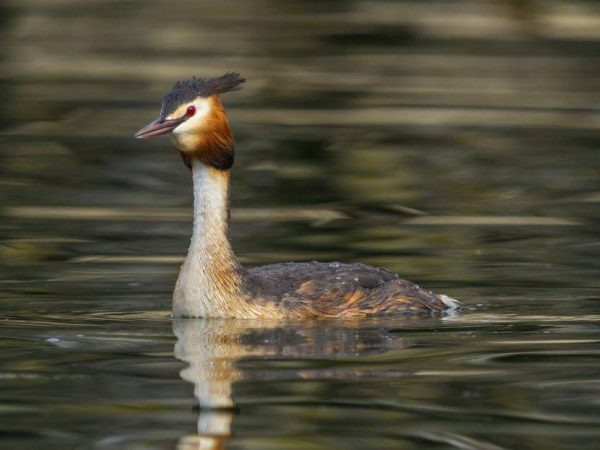Toadstool duck
The toadstool duck from the toadstool order of waterfowl is the only one of its kind, which got its name because of the specific taste of its meat, which has an unpleasant fishy smell.

Toadstool duck
About the toadstool breed
Toadstools, often mistaken for ducks, are not really one of those. They form another, separate class of birds and differ from the duck family in appearance. However, representatives of this species are often called the toadstool duck. The most common species in European territory is the great grebe duck, otherwise called the grebe.
The crested grebe is slightly smaller than the classic duck. Her height is in the range from 23 to 75 cm, weight is approximately from 120 to 1500 g. She has a thin neck and a slightly elongated straight beak. In the photo, you can note the distinctive features of the grebe, which are characteristic of the general characteristics of the appearance of the grebe:
- a red collar around the neck is the bird's business card,
- brown-red back,
- the cervical region, head region and abdomen are painted white.
In the spring, a pair of tufts of dark feathers grow in the Greater Greater, which in the photo looks like small ears. In winter, such a decoration (as well as a collar) cannot be seen on a bird.
Geography of distribution
The bird chose all continents as its habitat, with the exception of only Antarctica. She prefers to settle in the tropics in areas with temperate and subpolar climates. North of the Arctic Circle, you can see only one representative from the order of grebe - the red-necked. The rest of the species have not mastered such distant polar regions.
The geography of distribution of the great grebe is limited to isolated islands, for example, Madagascar and New Zealand. It is sometimes found in Africa.
Some species, such as the short-winged rolllandia, the Atitlan grebe and the Tachanovsky grebe, limited themselves to separate lakes located on the South American continent. In Russia, five species of representatives of the described ducks live: crested grebe, horned, black-necked, gray-cheeked and small.
Toadstools prefer closed water bodies and shallow lakes for their nesting, where the bottom is sandy and there is no current. In rare cases, they can be found on slowly flowing rivers. Only two representatives of the order of grebes - Magellanic and Western - preferred sea bays for themselves. South American birds have picked up lakes for habitation, located at an altitude of 4 km. Grebe can be seen on artificial reservoirs, and Central European grebes have long mastered city ponds.
Features of behavior
Inhabitants of the tropics and subtropics are prone to settling, moving exclusively to nearby sea coasts. Among the inhabitants of temperate climatic regions, migratory grebes are more common, which migrate during the nesting period in huge flocks, numbering from 20 to 750 thousand birds.
Greaters swim without much desire, although they know how to do it quickly.
The voice sounds of most toadstools, including Grebe, have many variations, but there are also silent representatives, among which is the Australian toadstool. Most often, the voice of toadstools ducks can be heard during the mating season and when the birds show aggression.
Some toadstools have up to 12 different sound combinations in their arsenal.
Mostly toadstool birds are daytime lovers, but sometimes they can be active at night in bright moonlight.
As a rule, solitary living is more suitable for grebes, only at the onset of the mating season and nesting season they get lost in pairs and in winter they can live in small groups. Only a few, for example, the tadpole, the silvery species, the western one, prefer a different way of activity and life and remain in colonies.
Nesting and breeding
The crested crested duck arrives for European residence in the period from March to April. Most mating games of birds take place on the water surface, when males observe an established strict ritual of courting a female. At the same time, grebes swim towards each other with plumage loose in the area of the collar, shaking their head, coming close to each other. Standing upright, they resemble penguins in their posture, offering algae bundles in their beaks as a gift.
The floating house for nesting in Greyhound is 0.6 m in diameter. The nest is built up to 0.8 m in height. The oviposition of the Greyhound contains up to 4 eggs of a pure white color, the shell of which after a while from the nearby rotting vegetation, the larger composition of which is reeds, acquires a brown tint.
Newly emerging on the 24th day, chicks can swim on their own after a short time.


